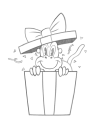Want more? Join the premium course and get full access to all lessons, demos, assignments, and critiques!
This lesson builds on what we learned in the last lesson by demonstrating a practical, step-by-step process for applying those concepts to achieve realistic shading. While the previous lesson defined the terms, this guide focuses on how to implement them sequentially using a sphere as an example.
1. Draw the Linear Layin
- Always begin by mapping out the shapes and structure linearly.
- This layin acts as a container and guide for placing your values accurately. Don't shade details in the wrong place.
2. Map Out the Shadows
- Form Shadow: Identify the light source and map the terminator line where the form turns away from the light. Instead of a sharp line, consider the soft edge of the core shadow which often sits on the terminator.
- Cast Shadow: Map where the object blocks light from hitting adjacent surfaces. Cast shadows help connect objects to their environment and describe the form they fall upon.
3. Separate Light and Shadow
- Fill the entire shadow area (form and cast) with a single, consistent dark value.
- Crucially: This initial value represents the lightest part of the shadow (the reflected light). It should be dark enough for clear contrast but not black.
4. Refine Core Shadow & Reflected Light
- Reflected light bounces from the environment into the shadow areas.
- Common Mistake: Making reflected light too bright. Rule: Reflected light must always be darker than any halftone value.
- Technique: Instead of erasing to create reflected light, darken the core shadow around it. This naturally makes the surrounding areas appear as reflected light.
- The Core Shadow is the part of the form shadow least affected by reflected light, often near the terminator. It's not always visible depending on the environment.
5. Model the Halftones
- Identify the Center Light (where the form directly faces the light source) as a guide.
- Halftones are the lit areas turning away from the center light, receiving direct light at an angle. They make up most of the lit area.
- Spend most of your effort rendering the subtle value changes here. Use directional strokes (hatching) that follow the form; be cautious with blending.
- Common Mistake: Making the halftone gradation too linear and even.
- Reality: The value transition is compressed near the terminator (gets dark faster) and is more subtle near the center light. Keep dark halftones close to the terminator.
- Check out Dorian Iten's lesson on Lambert's Cosine Law
6. Design the Highlight
- Add highlights last. The form should read well even without them.
- Create highlights by erasing or by shading around the highlight area earlier.
- Highlight vs. Center Light: A highlight is a reflection of the light source itself. Its position changes depending on the viewer's position.
- Highlight appearance depends on surface texture: soft/diffused on matte surfaces, sharp/crisp on shiny surfaces.
7. Deepen the Occlusion Shadow
- This is typically the darkest value, found where surfaces are very close or touching, blocking almost all light.
- It helps ground objects.
- Occlusion isn't just under objects; it occurs in any tight crevice (like between fingers).
8. Fade the Penumbra
- Most cast shadows have a soft transition zone, not a razor-sharp edge.
- Umbra: The dark part of the cast shadow where the light source is fully blocked.
- Penumbra: The lighter, fuzzy edge where the light source is only partially blocked. This occurs because light sources have size. Render this gradient for realism.
9. Make Final Adjustments
- Step back and review the relationships between all the values to ensure harmony. Adjust as needed.
* * *
We haven't learned much about edges yet, and controlling edges well is key to getting that really convincing 3D ball effect, so keep that in mind. Don’t beat yourself up if you struggle with the transitions. We have to jump in and start shading even before we have all the information.
But make sure you get your value relationships right, especially keeping that reflected light darker than your halftones. That's the main focus for now.
This lesson was the demonstration. Head over to the next lesson for the dedicated Project lesson where you can submit your drawings and start the assignment.
Want more? Join the premium course and get full access to all lessons, demos, assignments, and critiques!



































